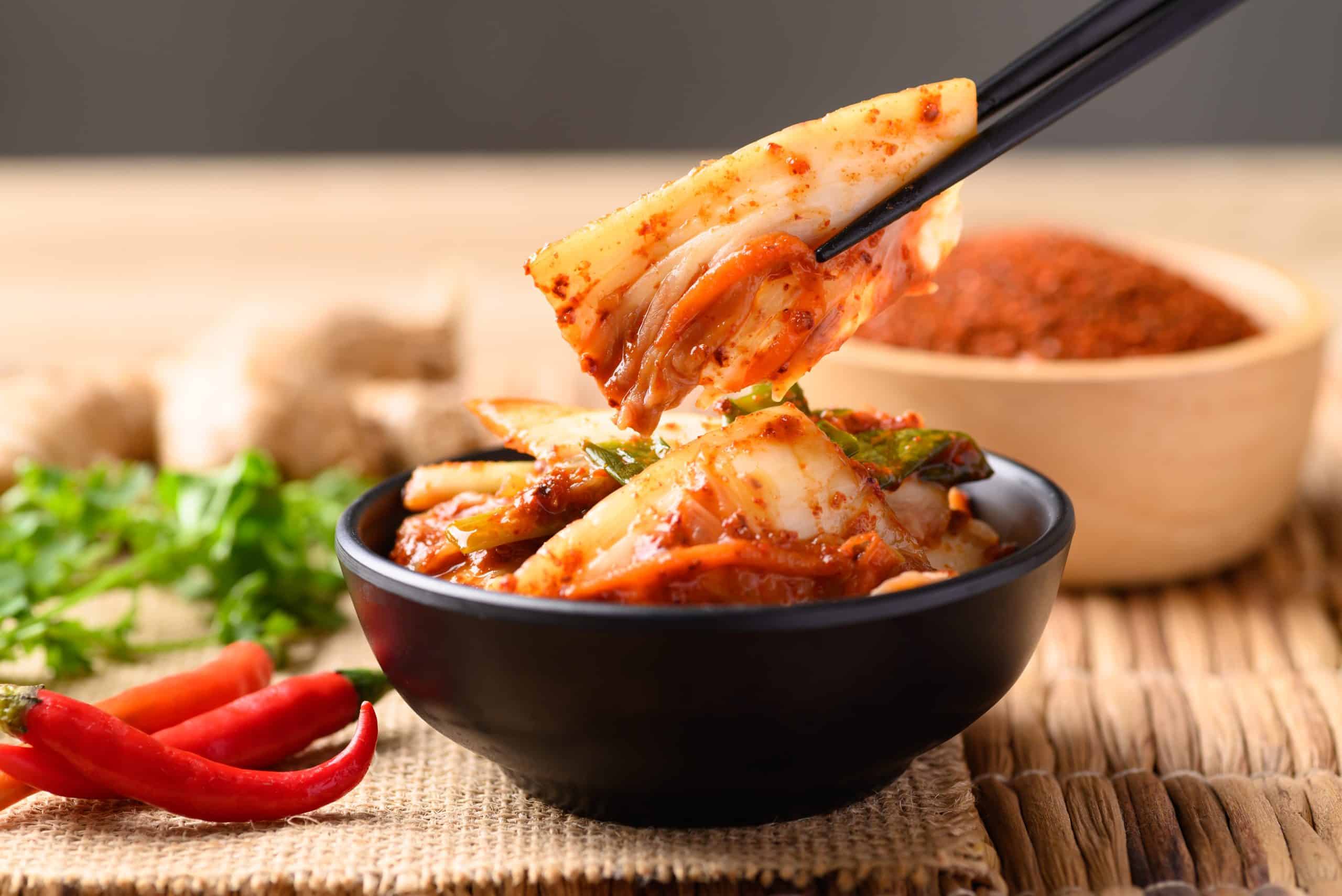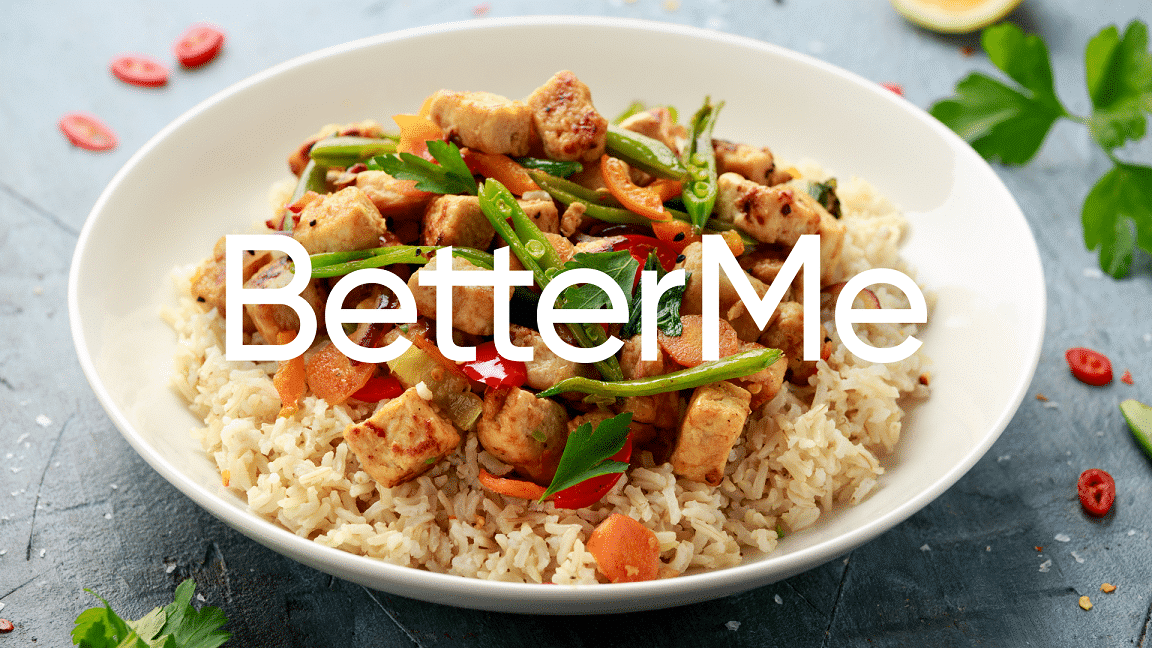Spicy, tangy, and bursting with flavor, Kimchi is more than the perfect sidekick to your Korean barbecue.
This Korean culinary staple is popularly incorporated into a variety of dishes – from fried rice to pancakes – and even enjoyed as a standalone snack.
But beyond its vibrant taste and texture, this fermented cabbage dish offers more than what meets the eye. It’s loaded with essential nutrients, offering a host of health benefits.
It has potentially gut-friendly properties, thanks to the fermentation process. And, it may even be helpful for weight loss, being low in calories but high in fiber.
Read on to find out where this cabbage-based side dish could fit into your healthy eating plan.
What Is Kimchi?
Kimchi, also known as gimchi, is a traditional Korean side dish made from fermented vegetables, primarily napa cabbage (2).
Other commonly used ingredients include garlic, ginger, scallions, and red chili peppers. The combination of these ingredients creates a unique blend of flavors – spicy, tangy, and slightly sour.
Interestingly, the fermentation process not only gives kimchi its distinct flavor but also preserves its nutrients, making it a powerhouse of essential vitamins and minerals.
It’s worth mentioning that napa cabbage is not the only ingredient used in kimchi. Other variations may include radishes, cucumber, or even eggplant. Each variation offers a different taste and texture.
Dropping pounds by the dozens without putting yourself through the wringer is everyone’s weight loss pipe dream. But what if we told you that the BetterMe app can make that happen? Keep yourself in prime shape with our fat-blasting workouts, delicious budget-sparing recipes, and body-transforming challenges with our app!
Is Kimchi High In Calories?
No, it isn’t. Kimchi is quite low in calories; especially when made in the basic, traditional way.
Here are some approximate calorie counts for different serving sizes of kimchi:
- 1 tbsp kimchi calories – 8
- Kimchi calories per 100g -16
- Kimchi calories 1 cup (150g) – 23
- Kimchi calories 500g – 76
Of course there will be variations in the calorie count, depending on the recipe and ingredients used. For example, kimchi made with added sugar or oil will have a higher calorie count.
But overall, kimchi is considered to be a low-calorie food.
Visit our blog titled – Chinese Food Calories discusses the calorie counts of popular Chinese dishes. The numbers may surprise you!
Is It Okay To Eat Kimchi Everyday?
Eating kimchi regularly is okay and may even be beneficial for overall health.
However, eating large amounts of kimchi every day may lead to an excessive intake of sodium or other potential additives over time.
The process of making kimchi involves adding salt, which is later rinsed off before consumption. Still, it is important to keep an eye on your sodium intake and opt for lower sodium versions if possible.
According to the United States Department of Agriculture (USDA), a serving of kimchi (1/2 cup or 75g) contains approximately 750 mg of sodium (3).
Yet, as per the Dietary Guidelines for Americans, the recommended daily intake of sodium is 2,300mg or less (4). People with high blood pressure or other health conditions that require a low-sodium diet should be mindful of their kimchi consumption.
Read more: Boxing Calories Burned: Lose Weight by Punching
Is Kimchi Good To Eat When Losing Weight?
Yes, kimchi can be a great addition to your weight loss diet. Here’s why:
- Low in calories: As mentioned earlier, kimchi is low in calories, yet high in nutrients. This means you can enjoy larger portions without worrying about consuming too many calories.
- High in fiber: Fiber helps keep you feeling full longer, reducing the chances of overeating. Kimchi is a good source of fiber, with nearly 3 g per half-cup serving (3).
- Probiotic benefits: The fermentation process involved in making kimchi creates probiotics, which are beneficial bacteria that may support gut health (1). A healthy gut has been linked to weight management and a lower risk of obesity.
- Flavorful substitute: Kimchi’s bold flavors can make it a great substitute for high-calorie, less nutritious condiments like mayonnaise or salad dressings. By incorporating kimchi into your meals you can cut back on unnecessary calories, while still enjoying delicious flavors.
Other Health Benefits Of Kimchi
In addition to its potential weight loss benefits, kimchi also offers other health benefits. These include:
May Have Antioxidant Properties
Kimchi contains several antioxidants, such as vitamins C and A, flavonoids, and carotenoids (2). These compounds help fight free radicals in the body and may protect against chronic diseases like heart disease and cancer.
A diet rich in antioxidants has also been linked to improved skin health and a reduced risk of premature aging.
May Improve Digestive Health
As mentioned earlier, kimchi’s fermentation process creates probiotics, which may help promote a healthy gut microbiome. These probiotics may help relieve symptoms of digestive disorders such as irritable bowel syndrome (IBS) and improve overall digestive health (1).
May Support Immunity
The combination of ingredients in kimchi, such as garlic and red chili peppers, may have immune-supporting properties (2). Garlic contains allicin, a compound that has been shown to have antibacterial and antiviral effects. Red chili peppers are rich in vitamin C, which is essential for a strong immune system.
May Have Anti-Inflammatory Effects
The garlic and ginger in kimchi are known to have anti-inflammatory properties (2). Chronic inflammation has been linked to various health issues, including heart disease, diabetes, and autoimmune disorders. Consuming foods with anti-inflammatory properties like kimchi may help reduce inflammation in the body.
May Help Improve Cholesterol Levels
Kimchi contains garlic, which has been suggested to have cholesterol-lowering effects. A study published in the Journal of Nutrition found that consuming fermented garlic extract led to a decrease in total and LDL (bad) cholesterol levels in rats with high cholesterol (5).
Our blog titled – Is Kimchi Healthy?, explores these health benefits of kimchi in detail.
Want to build an attention-grabbing bubble butt, blast away fat that’s stored in all the wrong places, spring-clean your diet, turn back the clock on your skin, skyrocket your self-confidence and shatter your insecurities? Check out the BetterMe app and set this plan in motion!
How to Make Your Own Kimchi
Making your own kimchi at home is easier than you think. Here are the steps to make a basic, traditional kimchi recipe:
Vegetable Choice
The first step in making kimchi involves selecting the right vegetables. The most traditional and commonly used vegetable is napa cabbage.
This leafy vegetable has a mild taste, which allows the flavors of the other ingredients to shine through. It also provides a pleasing crunch that adds to the overall texture of the dish.
That said, you aren’t limited to just napa cabbage. Other vegetables that can be used to make kimchi include:
- Cucumbers: These can be used to make the summer favorite oi-sobagi, or cucumber kimchi.
- Radishes: Popular varieties used in kimchi include daikon radish and Korean radish, both of which are available at most Asian grocery stores.
- Green Onions: Also known as spring onions, these are the star ingredient of pa kimchi.
- Chives: Specifically Korean chives, or buchu, are used to make buchu kimchi.
- White Radish: Also known as moo in Korean, is often used in dongchimi, a variety of water kimchi.
- Mustard Leaves: Used in gat kimchi, these leaves provide a unique, peppery flavor.
- Perilla Leaves: These leaves, known as kkaennip in Korean, are used to make kkaennip kimchi. This variety of kimchi is often eaten fresh, served as a side dish to accompany other Korean dishes.
- Eggplant: Commonly used in gaji kimchi, eggplants are known for their tender flesh and ability to absorb flavors well, making them an excellent choice for kimchi.
- Bok Choy: This leafy vegetable, known for its crisp texture and slightly bitter taste, is often used in poot baechu kimchi, a quick and easy variation of kimchi.
- Bamboo shoots, bean sprouts, and other vegetables can also be used in kimchi recipes.
Kimchi Paste
The next step is to make the paste that will give kimchi its signature flavor. The basic paste typically contains:
- Gochugaru (Korean red pepper flakes): This ingredient gives kimchi its spicy kick and vibrant red color.
- Garlic: Provides a pungent, savory flavor.
- Ginger: Adds a slight tang and warmth to the dish.
- Fish sauce: Often used as a source of umami, this fermented fish extract adds depth and complexity to the kimchi paste. If you are vegetarian or vegan, you can omit this ingredient or use an alternative like soy sauce or miso paste.
- Sugar: Balances out the spiciness and adds a touch of sweetness.
- Salt: A crucial ingredient for drawing out moisture from the vegetables to create brine, which is essential for the fermentation process.
- Rice flour: This helps thicken the paste and bind all the ingredients together.
Mix all these ingredients together to form a smooth, thick paste. Adjust the quantities of each ingredient according to your taste preferences.
Fermentation
The final step in making kimchi is the fermentation process. This can be done at room temperature or in the fridge, depending on how quickly you want your kimchi to ferment.
The longer you let it ferment, the more sour and tangy it will become. Most people prefer to ferment kimchi for 3-4 days at room temperature and then store it in the fridge, where it will continue to age and develop its flavors.
Making the Kimchi
Once you have your chosen vegetables and paste, it’s time to make kimchi. Here are the steps:
- Cut and wash your vegetables, removing any wilted or discolored pieces.
- In a large bowl, mix the cabbage with salt and let it sit for two to three hours to draw out moisture.
- Rinse the vegetables thoroughly and squeeze out any excess water.
- In a large bowl, mix the vegetables with the kimchi paste until well coated.
- Place the mixture in an airtight container or jar, pressing down to release any air bubbles and ensure that the vegetables are submerged.
- Let it ferment at room temperature for 3-5 days, depending on your preference of taste and texture.
- Once it reaches your desired level of fermentation, store it in the fridge to slow down the process and enjoy your homemade kimchi for up to a few weeks.
Kimchi can be enjoyed as a side dish or incorporated into various recipes, such as kimchi fried rice, kimchi pancakes, or even added to soups and stews.
Read more: Calories Burned Water Aerobics, or Why Aquafit is Good For Weight Loss
FAQs
How Much Kimchi Should I Eat for Gut Health?
There is no specific recommendation for how much kimchi to consume for gut health. However, incorporating a serving (1/2 cup or 75g) of kimchi into your meals a few times a week may provide some benefits for gut health.
Due to its high sodium content, you may want to alternate your gut-healthy kimchi consumption with other probiotic-rich foods like yogurt, kefir, or sauerkraut.
Does Kimchi Burn Belly Fat?
Kimchi doesn’t directly burn belly fat; no food does. However, as discussed earlier, kimchi can be beneficial for weight loss due to its low calorie and high fiber content.
In addition, incorporating probiotic-rich foods like kimchi into your diet has been suggested to promote weight loss, including in the abdominal area. This is because probiotics may help improve gut health, which has been linked to healthy weight management.
That said, a common side effect of consuming large amounts of kimchi is bloating, which makes your stomach appear bigger temporarily.
The bloating is caused by the fermentation process and is not a permanent effect. To avoid bloating, it’s best to consume kimchi in moderation and make sure you are also drinking enough water throughout the day. If you aren’t used to eating much fiber, increase your intake slowly to avoid gastrointestinal discomfort.
Can Eating Kimchi Every Day Destroy Gut Bacteria?
No, eating kimchi every day is not likely to destroy gut bacteria. In fact, the probiotics in kimchi may actually help improve gut bacteria balance and promote a healthy digestive system.
Is Kimchi a Carb or Protein?
Kimchi contains both carbohydrates and a small amount of protein. One serving (1/2 cup or 75 g) contains approximately 5 g of carbohydrates and 3 g of protein.
The Bottom Line
Kimchi is more than just a delicious side dish – it’s a nutrient-packed food with potential health benefits. Whether you’re looking to lose weight, improve your gut health, or support your immunity, kimchi can be a valuable addition to your diet. Just remember to keep an eye on the sodium levels and opt for homemade or low-sodium versions whenever possible.
DISCLAIMER:
This article is intended for general informational purposes only and does not serve to address individual circumstances. It is not a substitute for professional advice or help and should not be relied on for making any kind of decision-making. Any action taken as a direct or indirect result of the information in this article is entirely at your own risk and is your sole responsibility.
BetterMe, its content staff, and its medical advisors accept no responsibility for inaccuracies, errors, misstatements, inconsistencies, or omissions and specifically disclaim any liability, loss or risk, personal, professional or otherwise, which may be incurred as a consequence, directly or indirectly, of the use and/or application of any content.
You should always seek the advice of your physician or other qualified health provider with any questions you may have regarding a medical condition or your specific situation. Never disregard professional medical advice or delay seeking it because of BetterMe content. If you suspect or think you may have a medical emergency, call your doctor.
SOURCES:
- Health benefits of kimchi (Korean fermented vegetables) as a probiotic food (2014,nih.gov)
- Kimchi and Other Widely Consumed Traditional Fermented Foods of Korea: A Review (2016,nih.gov)
- KIMCHI (2021,fdc.nal.usda.gov)
- Sodium in Your Diet (2022,fda.gov)
- Study of Garlic Extracts and Fractions on Cholesterol Plasma Levels and Vascular Reactivity in Cholesterol-Fed Rats1 (2001,sciencedirect.com)










